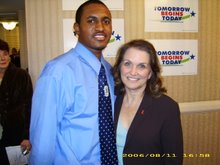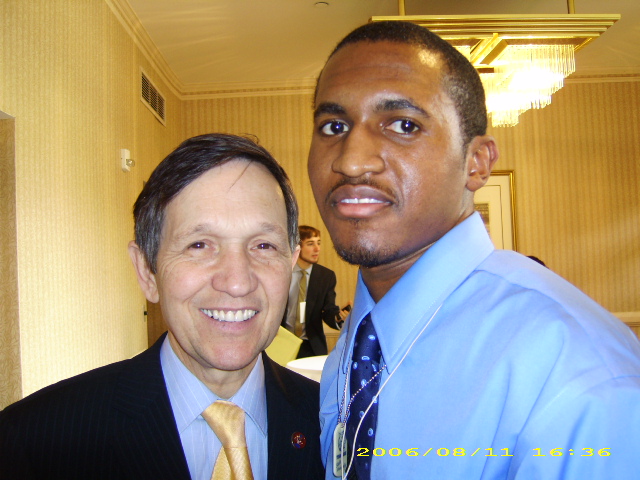Even as the housing industry begins to recover from its worst downturn in decades, a glut of unsold homes and record levels of home foreclosures are weighing on the industry. Construction of multifamily homes and apartments rose 1.5 percent to an annual rate of 598,000 units, the highest level since November, the Commerce Department said Thursday. That was slightly lower than the 600,000-unit pace economists had expected. And it remains more than 70 percent below the peak rate hit in 2006. The tentative improvements in housing are most likely a rebound "from unsustainably weak results ... reinforced by a temporary boost to demand" from the $8,000 first-time homebuyer tax credit that ends Dec. 1, Joshua Shapiro, chief economist at MFR Inc., wrote in a note to clients. "Gains from here on will probably be much more difficult to achieve," due to high unemployment, tight credit and a large number of new and existing homes already on the market, he said.
Applications for building permits, a gauge of future activity, rose a 2.7 percent in August to an annual rate of 579,000 units, slightly below the 580,000 level that had been forecast. Permits for single-family homes dipped 0.2 percent but rose for multifamily units by 15.8 percent. The 1.5 percent rise in housing starts followed a small 0.2 percent dip in July. The August strength reflected a 25.3 percent surge in construction of multifamily units, a volatile sector that had fallen 15.2 percent in July. The single-family sector dipped 3 percent last month to an annual rate of 479,000 units, the first setback following five straight monthly gains.
Paul Dales, U.S. economist at Capital Economics, noted that housing starts remain 74 percent below their 2006 peak and predicted the housing recovery would be a very "long-winded process."
Meanwhile, initial claims for unemployment benefits dropped last week to a seasonally adjusted 545,000 from an upwardly revised 557,000 the previous week, the Labor Department said Thursday. Wall Street economists expected claims to rise by 5,000, according to Thomson Reuters. The decline was the third in the past four weeks. The four-week average, which smooths out fluctuations, dropped 8,750 to 563,000. Despite the improvement, that's far above the 325,000 per week that is typical in a healthy economy. "The message here is that the labor market's healing process is agonizingly slow," Shapiro said.
The number of people claiming jobless benefits for more than a week rose by 129,000 to a seasonally adjusted 6.2 million. The continuing claims data lags initial claims by one week. When federal extended benefits are included, 9.01 million people received unemployment insurance in the week ending Aug. 29. That's down from 9.16 million the previous week. Congress has added up to 53 weeks of extended benefits on top of the 26 weeks provided by the states. Some economists said the overall housing construction gain was an encouraging sign that the worst is over for that troubled market. "This sector is likely to start adding to growth rather than holding back the economy," said Joel Naroff, chief economist at Naroff Economic Advisors.
Regionally, construction rose 23.8 percent in the Northeast and 0.9 percent in the Midwest. Activity was flat in the West and fell 2.4 percent in the South. Builders have been ramping up because buyers want to take advantage of the new federal tax credit for first-time homebuyers. The National Association of Home Builders said this week that its housing market index rose in September, reflecting growing optimism in the industry about rising home sales. The trade association said its index rose one point to 19, the highest reading since April 2008.
Homebuilders' stocks jumped following the release of that report and mostly moved higher early Thursday. Shares of Beazer Homes USA Inc., and Hovnanian Enterprises Inc., were each up more than 6 percent in morning trading. Financial results for homebuilders also were better than expected in the latest quarter. The Dow Jones U.S. Home Construction Total Stock Market Index has surged since bottoming in November but remains about 72 percent below the level achieved at its recent peak in 2005. Thursday's reports come a day after the Federal Reserve said production by the nation's factories, mines and utilities increased for the second straight month in August, the latest sign the economy is recovering.
But the economy isn't improving fast enough to spur greater hiring. Fed Chairman Ben Bernanke on Tuesday said the recession is likely over, though he noted that the economy isn't likely to grow fast enough to lower unemployment anytime soon. The jobless rate is widely expected to peak next year above 10 percent, up from its current 9.7 percent. Some analysts say that claims need to drop below 400,000 before the unemployment rate will start to decline. More job cuts were announced this week. Drugmaker Eli Lilly & Co. said Monday that it will cut 5,500 jobs over the next two years, 14 percent of its work force, as it restructures the company into five business units. Among the states, Washington had the largest increase in claims of 4,546, which it attributed to greater layoffs in the construction, public administration, and manufacturing industries. The next largest increases were in Pennsylvania, Massachusetts, North Carolina and Illinois. The state data lag initial claims by a week. California had the largest drop in claims of 2,751. The next largest decreases were in New York, Wisconsin, Texas and New Jersey.
Now while the housing and jobless data shows it is slow recovery there is still another question out there in terms of if the stimulus worked. There are some economists who say the stimulus didn’t work and data shows government transfers and rebates have not increased consumption at all. Is the American Recovery and Reinvestment Act of 2009 working? At the time of the act's passage last February, this question was hotly debated. Administration economists cited Keynesian models that predicted that the $787 billion stimulus package would increase GDP by enough to create 3.6 million jobs. Now John F. Cogan, John B. Taylor and Volker Wieland’s research shows that more modern macroeconomic models predicted only one-sixth of that GDP impact. Estimates by economist Robert Barro of Harvard predicted the impact would not be significantly different from zero.
Now, six months after the act's passage, we no longer have to rely solely on the predictions of models. We can look and see what actually happened. Consider first the part of the package that consists of government transfers and rebates. These include one-time payments of $250 to eligible individuals receiving Social Security, Supplemental Security Income, veterans benefits or railroad retirement benefits--and temporary reductions in income-tax withholding for a refundable tax credit of up to $400 for individuals and $800 for families with incomes below certain thresholds. These payments, which began in March of this year, were intended to increase consumption that would help jump-start the economy. Now that a good fraction of these actions have taken place, we can assess their impact.
The nearby chart reviews income and consumption through July, the latest month this data is available for the U.S. economy as a whole.

Consider first the part of the chart pertaining to the spring of this year and observe that disposable personal income (DPI)--the total amount of income people have left to spend after they pay taxes and receive transfers from the government--jumped. The increase is due to the transfer and rebate payments in the 2009 stimulus package. However, as the chart also shows, there was no noticeable impact on personal consumption expenditures. Because the boost to income is temporary, at best only a very small fraction was consumed.
This is exactly what one would expect from "permanent income" or "life-cycle" theories of consumption, which argue that temporary changes in income have little effect on consumption. These theories were developed by Milton Friedman and Franco Modigliani 50 years ago, and have been empirically tested many times. They are much more accurate than simple Keynesian theories of consumption, so the lack of an impact should not be surprising.
Indeed, one need not have looked any further than the Bush administration's Economic Stimulus Act of 2008 to find plenty of evidence that temporary payments of this kind would not jump-start consumption. That package made one-time payments and rebates to people in the spring of 2008, but, as the chart shows, failed to stimulate consumption as had been hoped. Some argued that other factors such as high oil and gasoline prices caused consumption to fall during this period and that consumption would have been even lower without the stimulus, but no significant impact of these rebates is found even after controlling for oil prices.
Consider next the government-spending part of the stimulus package. The Obama administration points to the sharp reduction in the decline in real GDP from the first to the second quarter of 2009 as evidence that the package is working. Economic growth was minus 6.4% in the first quarter and minus 1% in the second quarter, so the implied improvement of 5.4 percentage points is indeed big. But how much of that improved growth rate can be attributed to higher government spending due to the stimulus? If we rely on predictions of models, again we see disagreement and debate. According to Cogan, Taylor and Wieland’s research with modern macroeconomic models, the increase in government spending would add less than a percentage point, a relatively small portion. The model predictions cited by the administration's economists suggest a much larger portion: two to three percentage points. Prof. Barro's model predicts zero.
So let's look at the data on the contributions of government spending and other components of GDP to the 5.4 percentage-point improvement. By far the largest positive contributor to the improvement was investment--which went from minus 9% to minus 3.2%, an improvement of 5.8% and more than enough to explain the improved GDP growth. Investment by private business firms in plant, equipment and inventories, rather than residential investment, were the major contributors to the investment improvement. In contrast, consumption was a negative contributor to the change in GDP growth, because consumption growth declined following the passage of the stimulus package.
One is hard put to see what specific items in the stimulus act could have arrested the decline in business investment by such a magnitude. When one looks at monthly investment indicators--such as new orders for nondefense capital goods--one sees a flattening out starting early in the first quarter of 2009, well before the package went into operation. The free fall of investment orders caused by the financial panic last fall stabilized substantially by January, and investment has remained relatively stable since then. This created the residue of a very large negative growth rate from the fourth quarter of 2008 to the first quarter of 2009, and then moderation from the first quarter to the second of 2009. There is no plausible role for the fiscal stimulus here.
Direct evidence of an impact by government spending can be found in 1.8 of the 5.4 percentage-point improvement from the first to second quarter of this year. However, more than half of this contribution was due to defense spending that was not part of the stimulus package. Of the entire $787 billion stimulus package, only $4.5 billion went to federal purchases and $17.7 billion to state and local purchases in the second quarter. The growth improvement in the second quarter must have been largely due to factors other than the stimulus package.
Incoming data will reveal more in coming months, but the data available so far tell us that the government transfers and rebates have not stimulated consumption at all, and that the resilience of the private sector following the fall 2008 panic--not the fiscal stimulus program--deserves the lion's share of the credit for the impressive growth improvement from the first to the second quarter. As the economic recovery takes hold, it is important to continue assessing the role played by the stimulus package and other factors. These assessments can be a valuable guide to future policy makers in designing effective policy responses to economic downturns.
Sources:
Mr. Cogan, a senior fellow at the Hoover Institution, was deputy director of the Office of Management and Budget under President Ronald Reagan. Mr. Taylor, an economics professor at Stanford and a Hoover senior fellow, is the author of "Getting Off Track: How Government Actions and Interventions Caused, Prolonged and Worsened the Financial Crisis" (Hoover Press, 2009). Mr. Wieland is a professor of monetary theory at Goethe University in Frankfurt, Germany.


























No comments:
Post a Comment